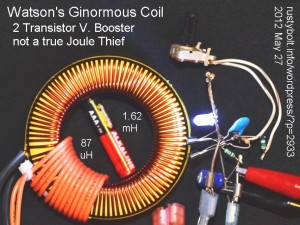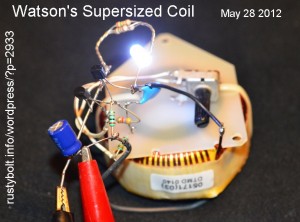 Well, I’ve finally got one of the coils I got from BG Micro hooked up to a two transistor voltage boost circuit (not a true Joule Thief) to see how well it works. The price was reasonable – a penny more than two bucks.
Well, I’ve finally got one of the coils I got from BG Micro hooked up to a two transistor voltage boost circuit (not a true Joule Thief) to see how well it works. The price was reasonable – a penny more than two bucks.
It’s drawing about 65 milliamps from the 1.5V supply, and putting out about 16 milliamps to the LED. The frequency was about 35 kHz, but it seemed to drift a lot. As can be seen in the picture, the coil is absurdly huge; the AAA cell fits nicely inside of the hole. The winding that’s orange insulated wire is 87 microhenrys and the ‘main’ winding of magnet wire is 1.62 millihenrys. It worked okay on both windings.
The beast is very heavy: 617 grams or about a pound and 6 ounces. The weight leads me to believe that maybe the core is actually iron or alloy. But then the copper wire is heavy, and may be the reason why it seems to weigh more than what a ferrite core that size should weigh. However this is the first time I’ve picked up a core as large as this one, so maybe it’s all in my imagination.
 I still have to try out the other toroid core I got from BG Micro. It’s not quite as big, but it’s still huge by comparison to the others I’ve been using for JTs. Their ad says the PC board ‘insulator’ is attached with wire ties, but that doesn’t tell the whole story. The coil is also glued to the board with epoxy, which can be seen in their picture. It will take a lot more than just cutting the wire ties to get the board to come off.
I still have to try out the other toroid core I got from BG Micro. It’s not quite as big, but it’s still huge by comparison to the others I’ve been using for JTs. Their ad says the PC board ‘insulator’ is attached with wire ties, but that doesn’t tell the whole story. The coil is also glued to the board with epoxy, which can be seen in their picture. It will take a lot more than just cutting the wire ties to get the board to come off.
I connected this coil up to the same circuit that I used for the other coil. It works just about the same (see the picture). It’s also heavy for its size, 327 grams or 11.5 ounces.
If you need some big toroids for your experiments, BG Micro is the place to get them – the prices are right. But don’t expect them to be available forever, because these surplus places get a load of unique parts, and when they’re gone, they probably will never have them again.
Back to experimenting…